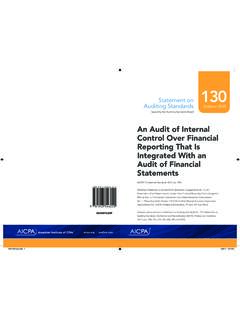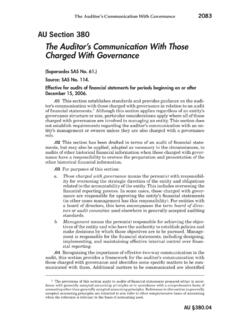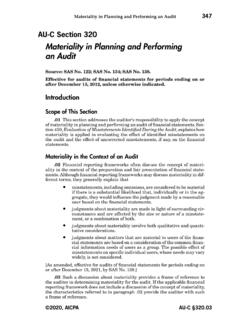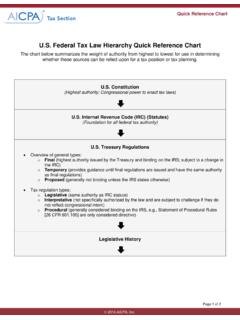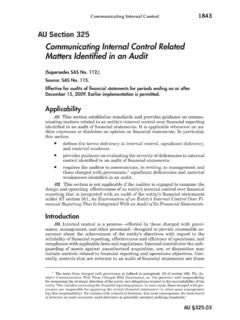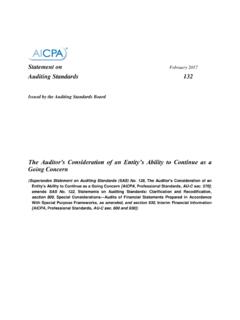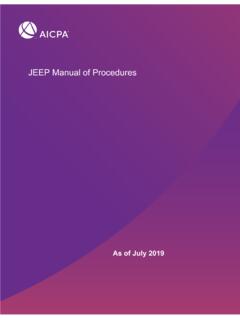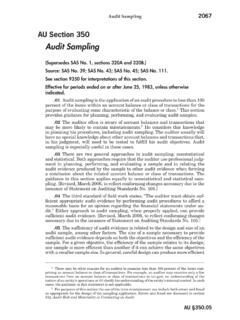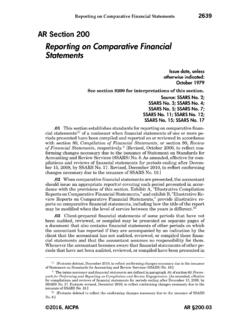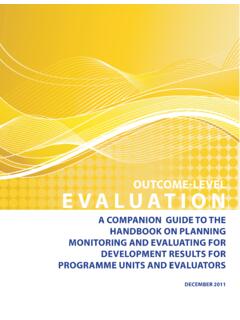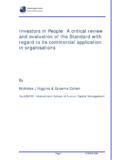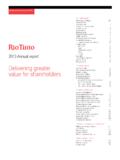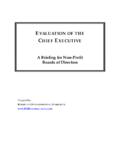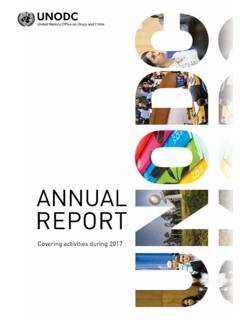Transcription of Obtaining Quality Employee Benefit Plan Audit Services The ...
1 Obtaining Quality Employee Benefit plan Audit Services : the request for proposal and auditor evaluation process The aicpa Employee Benefit plan Audit Quality Center has prepared this document to assist plan sponsors and other stakeholders in the proposal and evaluation process to obtain Quality Audit Services for Employee Benefit plans. This tool addresses each step of the proposal and evaluation process . It describes the Request for proposal (RFP) contents and contains a checklist of items that should be considered in preparing an RFP. It also discusses the proposal evaluation and auditor selection process , and provides information about how to find an auditor.
2 It should be used for reference purposes, taking into consideration the individual plan sponsor s needs. For more information about the aicpa Employee Benefit plan Audit Quality Center and Employee Benefit plan audits, visit the Center s website at The importance of a Quality plan Audit Generally, Federal law requires Employee Benefit plans with 100 or more participants to have an Audit as part of their obligation to file an annual return/report (Form 5500 Series). Independent audits of Employee Benefit plan financial statements are an important accountability mechanism. If your Employee Benefit plan is required to have an Audit , it is the plan administrator s duty to hire an independent qualified public accountant, and to ensure that the plan has obtained a Quality Audit in accordance with Employee Retirement Income Security Act of 1974 (ERISA) and Department of Labor (DOL) requirements.
3 The sponsor of the plan is the plan administrator under the law unless another individual or entity is specifically designated to assume this responsibility. You should be aware that the hiring of a plan auditor is considered a fiduciary function. As such, plan administrators should use the same care and prudence in hiring a plan auditor that they use when hiring any individual or entity that provides Services to the plan . A Quality Audit will help protect the assets and the financial integrity of your Employee Benefit plan and help you determine whether the necessary funds will be available to pay retirement, health, and other promised benefits to your employees.
4 The higher the Quality of a plan s financial statement Audit , the more reliable the information used to manage and administer the plan . A Quality Audit also will help you carry out your legal responsibility to file a complete and accurate annual return/report for your plan each year. As such, selection of an experienced and reliable auditor is very important. ERISA holds plan administrators responsible for ensuring that plan financial statements are properly audited in accordance with generally accepted auditing standards (GAAS). There is a significant amount of risk to plan sponsors associated with the audits of their ERISA plans.
5 Recent DOL studies of Audit Quality have identified significant deficiencies in plan audits. Accordingly, the DOL has implemented various enforcement strategies with respect to Audit deficiencies. The penalties for such Audit failures can be substantial. The DOL can assess penalties on plan sponsors of up to $2,194 per day (indexed annually), without limit, per annual report filing where the required auditor s report is missing or deficient. plan sponsors should make the selection of the plan auditor a high priority and exercise due care during every phase of the auditor selection process . 2 | P a g e While ERISA requires plan fiduciaries to ensure that only reasonable compensation is paid for Services when selecting an auditor, the reasonableness of fees must be analyzed in comparison with the Quality of the required Services to be provided.
6 Hiring a firm that lacks knowledge of the specialized nature of the industry and skills necessary to perform plan audits conflicts with the stated goal of ERISA to protect plan participants. Only after the technical evaluation is complete and the qualified respondents have been identified should you review the prices offered by the qualified respondents. Finding an Audit firm The DOL s Employee benefits Security Administration (EBSA) has developed a booklet titled Selecting an Auditor for Your Employee Benefit plan to assist plan administrators in selecting an auditor. It also provides information about reviewing the Audit work and report.
7 You can find this booklet at aicpa Employee Benefit plan Audit Quality Center member firms show their commitment to providing Quality Audit Services to ERISA plans by voluntarily adhering to higher standards of Audit Quality in their policies, procedures and training related to the performance of Benefit plan audits. Those standards are the benchmark of their commitment to Quality performance and client service. You can find Audit firms in your area on the Center s website at The request for proposal (RFP) General information about the RFP The preparation of a sound RFP is an important part of the proposal process .
8 A Quality RFP will determine the Quality of the respondents and will help reduce the time and effort expended in the overall RFP and selection process . It is critical that you as a plan sponsor ask informed questions during the proposal process in order to obtain adequate information on which to base your final decision to hire an Audit firm. In addition, it is important that you provide Audit firms with sufficient information about the nature of the plan and the engagement to allow them to make a meaningful and comprehensive proposal that addresses your specific needs. The RFP should outline the proposal and selection process , as well as summarize the background, objectives, expectations, and requirements of the engagement to be undertaken.
9 Therefore, the following should be remembered when preparing the RFP: Communicate the facts and conditions surrounding the engagement to be completed. State your objectives and requirements clearly and thoroughly. Be specific about the information needed to properly evaluate the proposal . Require the proposal to be presented in a common format to allow for efficient and effective evaluation and comparison. The introduction section The introduction section of the RFP should provide a general description of the nature and scope of the engagement to be performed. It should: Describe why the RFP is being released.
10 Discuss in general terms the objective to be achieved and the reason professional CPA Services are being sought. Discuss the term of the engagement, such as the length of time the contemplated contract covers (for example, an annual or a multi-year engagement), along with renewal options. Provide an overview of how the RFP is structured and describe what information or supporting documents are contained in the appendixes, attachments, or the body of the RFP document. The introduction section also should include the following procedural information: Whether there will be a pre- proposal conference for firms interested in responding to the RFP Name of the contact person if further information is needed to respond to the RFP Number of copies of the proposal that must be provided Due date of the proposal Timeline for each stage of the process , including selection of finalists, firm interviews, and award of engagement (this information is often presented in a table format for easy reference)
